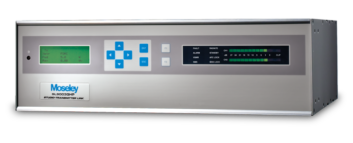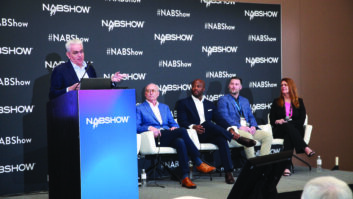The author is president of Tom Ray Broadcast Consulting.
In 2018, it was coming time for a new main transmitter at WJMJ(FM) Radio in Hartford, Conn., owned by the Archdiocese of Hartford.
Father John Gatzak wanted to further the message of WJMJ to the community and wanted to go HD Radio. Looking at the situation, we looked to see if we could move WJMJ’s transmitter because the signal skimmed the top of Avon Mountain, causing a shadow in the city of license, and the HD coverage would have been poor, at best.
We found that not only could we move the transmitter to Rattlesnake Mountain in Farmington, Conn., but we would be able to go from a Class B1 to a full Class B.
While this was good news, we were now presented with an issue. We needed to transport three stereo channels of audio up to Rattlesnake, preferably via microwave STL. And I wanted to have an IP backup in the event of a failure of the RF side. We knew we had a shot to Rattlesnake because we had a Moseley Starlink STL repeater at the site, as we could not see the old main site from the studios in Prospect, Conn.
Linear Stereo
Looking at the systems available, we chose to go with the Moseley Starlink SL9003QHP-8SLAN. There were many reasons, not the least of which was Moseley’s reputation for building rock-solid products.
 WJMJ, while being a religious station, runs a ’70s, ’80s and ’90s format, with many other genres of music mixed in including a classical block, in addition to religious programming on Sundays. So the main analog channel and the HD1 audio quality were of prime concern.
WJMJ, while being a religious station, runs a ’70s, ’80s and ’90s format, with many other genres of music mixed in including a classical block, in addition to religious programming on Sundays. So the main analog channel and the HD1 audio quality were of prime concern.
The Starlink would allow us to have a linear stereo channel with no data compression for the main channel audio — perfect.
Doing so would allow running the other two stereo channels at 192 kHz data rate, AAC audio. From experience, I know that the AAC algorithm plays nicely with the HD Radio codec. The plan would be to put Eternal World Network in Spanish on the HD2, which would be evolved into a local Hispanic channel in the near future, and to put Eternal World Radio Network on the HD3.
While both are primarily talk oriented, the HD subs are currently being run in mono — but the stereo capability of the Starlink would allow us to take those channels stereo in the future. Even at 192 kB AAC from the STL, the HD subchannels, running at 32 kB each, sound surprisingly good.
The Starlink is capable of transporting four stereo audio channels in the RF channel (or eight mono audio channels), and four stereo IP channels from one end to the other.
From the factory, the Starlink came configured with the RF channels the way I wanted them. The hard part was configuring the IP channels.
Word of warning — make sure you put the IP side of the Starlink behind a good firewall router, and open only the ports necessary. I initially was given an IP link to the outside world — naked — which worked for about 20 minutes, then the entire unit on the transmit side started rebooting, including the RF side.
Working with the Moseley tech support crew showed that our connection was being attacked with people trying to break in. The resultant overload of the IP side was causing the unit to reboot on a regular basis — we’re talking roughly every 30 seconds. Once it was behind a firewall, everything has been fine.
The audio side of the Starlink is based on Moseley Rincon technology.
My pet peeve with the system is that you need to read multiple manuals — including the Rincon manual — to learn to set up the IP streams correctly. Each stream requires setting up a profile describing the codec and data rate to be used, so you need to understand your available IP bandwidth before you start. Each stream requires its own separate IP port from transmit to receive side, so you will need to open up the necessary ports in your router to the receiver — in our case, we opened three.
Robust
Once the unit was correctly set up — and it took a little trial and error to do so — the IP streams have been solid. In fact, I put them on the air recently when we had the antennas realigned after the TV repack, as there are five TV stations on the tower we are on and there was much activity near our antenna. The streams were solid and sounded good on the air during the realignment.
The RF side of the Starlink SL9003QHP-8SLAN features 5 W of output, as opposed to the 1 W of output featured in the older versions of the Starlink system. This adds robustness to the digital signal at the receiver — in our case, the shot is approximately 16 miles.
It has been on the air almost two years now, and I can count the data errors on one hand. This is through thunderstorms, ice storms, snow and heavy rain. I haven’t gotten that panic call yet where the digital STL audio quits.
The Starlink SL9003QHP-8SLAN can be accessed through a web browser and through SNMP. The disappointing part of this is that you can only access the Rincon (audio) part of the system. You cannot control the RF side nor see the RF parameters. Moseley really needs to address this, as having this information available via web browser would be quite helpful when trouble arises.
It would also be nice if the Starlink allowed automatic switching to the IP streams, but alas, this is not the case, so we have external switching in place to do so.
A nice feature of the Starlink is that you can set up any output to be whatever audio source you desire — IP or radio. We use the AES outputs for the analog/HD1, the HD2 and the HD3 and I feed the main channel audio AES to the Starlink transmitter feeding the backup site. I have the analog audio ports set up so that the main channel audio feeds a backup audio processor, and the HD subs feed the analog input ports on the HD subchannel processors as backup.
Overall, the value and quality we received for the money we paid, and the reputation of Moseley products and support, have given us a reliable STL that does exactly what we need. Now, if Moseley could just give us a full manual with all the answers in one place, I’ll be a very happy camper.
The Moseley Starlink SL9003QHP-8SLAN is an excellent choice for your multichannel HD operation or to just feed audio to more than one station.
Radio World User Reports are testimonial articles intended to help readers understand why a colleague chose a particular product to solve a technical situation.
For information, contact Bill Gould at 805-968-9621 ext. 785, email [email protected] or visit www.moseleysb.com.






